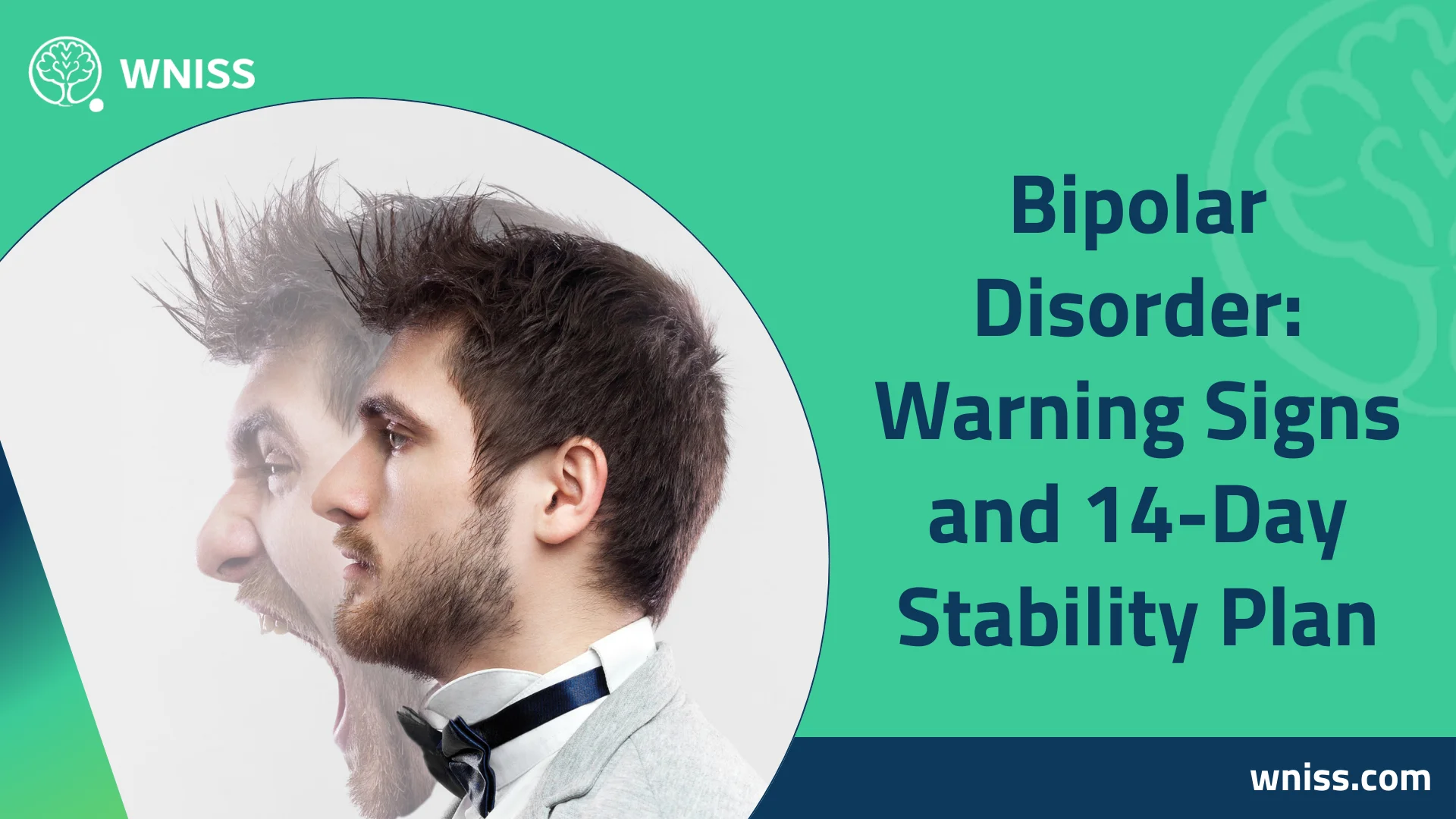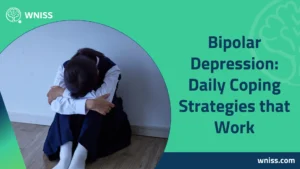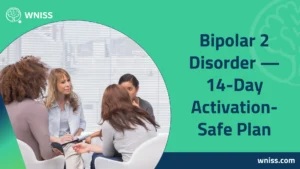When people search for bipolar disorder, they’re often looking for more than definitions—they want a plan that works day to day. Bipolar is a cyclical mood condition marked by episodes of depression and periods of mania or hypomania, affecting sleep, energy, focus, relationships, and work. The good news: with the right mix of medication, structured psychotherapy, and lifestyle rhythm, recovery is not just possible—it’s common.
Bipolar Disorder Deep Meaning
Think of bipolar disorder as a pattern over time, not a single rough day. Episodes bring predictable shifts in sleep, energy, and judgment—then settle with treatment and routine.
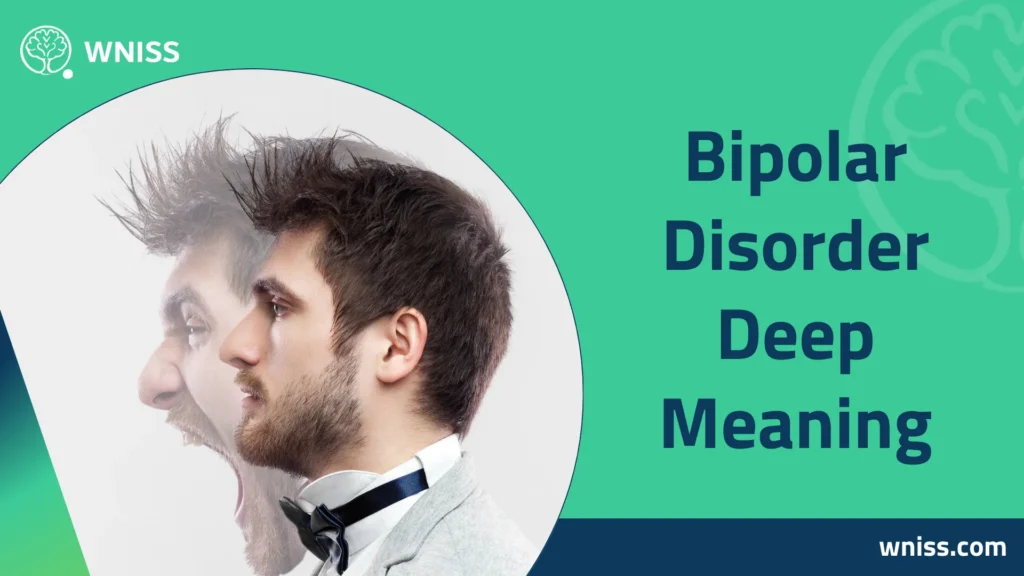
In everyday life you might notice:
- Mania/Hypomania (“up” states): reduced need for sleep, faster speech/ideas, unusual confidence or irritability, risk-taking (spending, travel, sexual risk); severe mania can include psychotic features (grandiosity, paranoia).
- Depression (“down” states): low mood or loss of interest, fatigue, slowed thinking, sleep/appetite change, guilt, hopelessness; in severe cases, thoughts of death.
- Between episodes: many people feel near baseline—especially when sleep and routines hold steady. These patterns track with national health guidance.
Types of Bipolar Disorder
A better label leads to better guardrails.. The type depends on the height of the “up” and the burden of depression, plus specifiers that fine-tune treatment.
At-a-glance types:
- Bipolar I: at least one manic episode (often with major depression elsewhere on the timeline).
- Bipolar II: at least one hypomanic episode and one major depressive episode; depression often dominates the year.
- Cyclothymic disorder: 2+ years of sub-threshold mood swings.
- Specifiers that change care: mixed features (depressed yet sped-up/irritable), psychotic features, rapid cycling. Authoritative sources summarize these patterns for patients and families.
Early-Warning Signs
People often ask for the “first sign” of bipolar. It’s rarely just one symptom; it’s a cluster you can spot and respond to. When sleep need falls and speed rises, treat it like a weather alert—tighten routines and contact care.
Actionable cluster:
- <6 hours sleep for 1–2 nights with normal or rising energy
- Faster speech/ideas, unusual confidence or irritability
- Spending surges or big, sudden plans
- A depressed mood that’s agitated or sped-up (mixed features)
These cues align with public clinical guidance and patient resources.
Why It Happens
There’s no single cause; think biology + rhythms + stress + habits. That means you can’t control your starting point—but you can change your exposure to triggers. Sensitive mood/reward/sleep circuits meet modern life (late nights, bright screens, pressure), and episodes follow.
Practical levers:
- Biology & genetics: family patterns and brain-circuit sensitivity.
- Circadian disruption: irregular bed/wake times, night shifts, jet lag, and low morning light destabilize mood—hence rhythm-based therapies.
- Stress load & substances: chronic stress and alcohol fragment sleep; stimulants and some antidepressants can destabilize susceptible patients—decisions must be individualized.
Diagnosis (more than any “bipolar test”)
There’s no single lab test; diagnosis is a structured clinical assessment that ends with a plan you can run, not just a name. Good clinicians map the timeline (episodes across months/years), check function & safety, and rule out medical/substance mimics.
Expect to see:
- A clinical interview covering mood, sleep, speed/spending, family history, and risk.
- Brief rating scales to track change (they don’t replace judgment).
- Rule-outs & overlaps: thyroid disease, sleep apnea, ADHD/trauma, and substance effects.
- Specifiers (mixed or psychotic features) that change medication strategy and urgency. These steps mirror NICE’s approach to recognition, assessment, and management.
Treatment That Works (integration beats)
Best outcomes come from medication + psychotherapy + rhythm protection, with routine measurement so progress is visible.
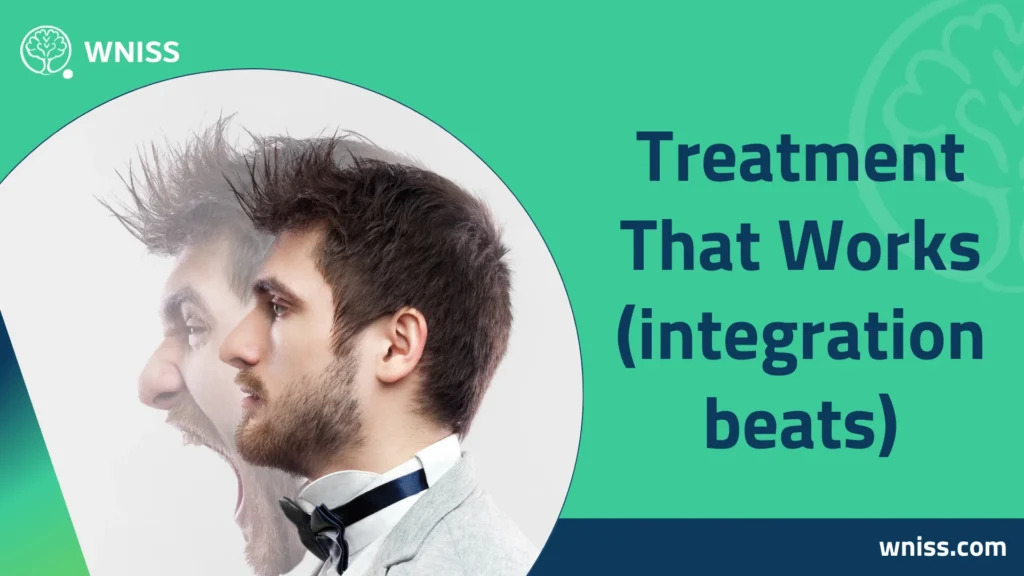
Medication (foundation):
- For mania/hypomania and bipolar depression, guidelines support mood stabilizers and selected atypical antipsychotics; options are tailored to phase and history.
- Antidepressant monotherapy is not recommended in bipolar I and is contraindicated in mixed/manic states; if considered for bipolar depression, it’s usually with a mood stabilizer and close monitoring for activation.
- New approvals and updates appear periodically (e.g., iloperidone/Fanapt received a 2024 FDA approval for manic/mixed episodes in Bipolar I), so prescribers review the latest evidence.
Psychotherapies with teeth:
- CBT for Bipolar: graded activation, cognitive tools, activation-safety rules for decisions.
- IPSRT (Interpersonal & Social Rhythm Therapy): stabilizes bed/wake, meals, activity blocks, and social timing—behavioral medicine that protects the body clock.
- FFT (Family-Focused Therapy): scripts helpful responses, reduces conflict, and sets a shared early-warning/crisis plan. Major guidelines and reviews support these approaches alongside medication.
Rhythm & routine (quiet levers, big returns):
- Fixed sleep window (±30 min)
- Morning light within 60 minutes of waking
- Caffeine cut-off ~8 hours before bed; devices out of bed
- Brief daily movement and a one-line nightly log (sleep hours, mood 1–10, meds taken, one “kept promise”).
These basics reflect WHO’s emphasis on combining medicines with psychosocial care.
A 14-Day Stability Plan (tiny moves, real protection)
Motivation varies; calendars don’t. Pre-decide two weeks so decisions aren’t left to mood at 11 p.m.
- Days 1–3 — Install anchors
- Pick a sleep window (e.g., 11:30–07:00) and hold it within ±30 minutes—even after a bad night.
- Get 10–20 minutes of morning light and add a 5–10 minute movement block (walk, stretch).
- Start your one-line nightly log and list 3 red flags (e.g., sleep <6 h ×2 nights, racing ideas, spending surge).
- Days 4–7 — Reduce noise & rehearse wins
- Caffeine last call 8+ hours before bed; screens down 60 minutes before bed; devices out of bed.
- Behavioral activation: 2 tiny tasks/day (5–20 min)—one self-care, one life-admin.
- Opposite action: when urge = avoid, do the easiest version for 5 minutes.
- Days 8–10 — Add structure & support
- Block a daily focus hour after light/movement for the hardest task.
- Schedule two low-stakes social contacts (walk/text/coffee).
- Hold a 15-minute partner/family check-in: appreciations → what helped → one small change; confirm escalation triggers.
- Days 11–14 — Stress-test & tune
- Simulate a late meeting or travel night; keep the same wake time next morning; use light + a short walk to reset.
- Review your log with a clinician/coach; keep two habits, tweak one friction point (earlier caffeine cut, firmer wind-down).
Start Feeling Steadier—With One Coordinated Online Plan (WNISS)
At WNISS, we turn evidence into small, repeatable moves that fit your life:
- Fast, compassionate online assessment: we map your episode history, sleep, triggers, and goals—then hand you a plain-English plan for the next 2–4 weeks.
- Therapy you’ll actually use: IPSRT + CBT to stabilize rhythms and restart momentum, plus family scripts that make help… helpful.
- Medication coordination: we liaise with your prescriber on activation-safe choices, smart dose timing, and travel/shift-work sleep.
- Dashboards you can trust: 60-second nightly logs and weekly reviews—so progress becomes visible, not vague.
Ready to steady your weeks? Book a confidential session now at WNISS and start your 14-day plan with a specialist by your side.
FAQs about Bipolar Disorder
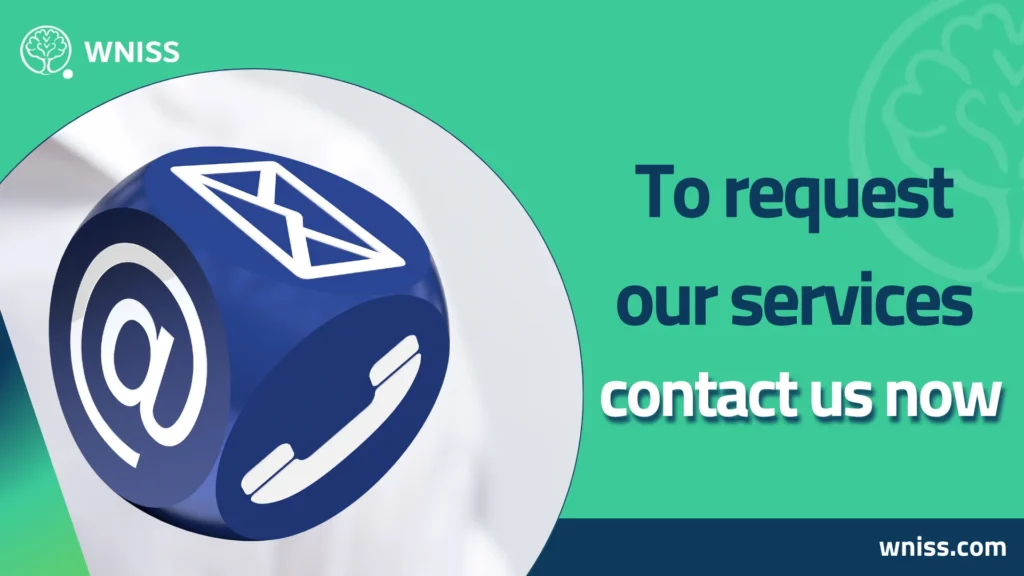
How long is a bipolar episode?
Episodes vary. Manic/hypomanic and depressive episodes typically last days to weeks without treatment, and many shorten significantly with guideline-based care and stable routines. Mixed or psychotic features can change urgency and treatment settings. Authoritative patient guides outline these ranges and emphasize early care.
Can bipolar be cured?
There’s no “once-and-done” cure, but recovery is common with ongoing care: medication, structured psychotherapy, and rhythm protection. Most people can live meaningful, productive lives when treatment and routines hold steady.
What age does bipolar start?
Symptoms often begin in late adolescence or early adulthood, though onset varies (children and later-life onset also occur). Early recognition and sustained care improve outcomes.
Are antidepressants safe for bipolar depression?
Sometimes—and usually with a mood stabilizer. Major guidelines caution that antidepressant monotherapy is not recommended in bipolar I and is contraindicated in mixed/manic states due to switch risk; if used, monitor closely for falling sleep need, rising speed, or spending surges.
Which therapies help most?
Evidence supports CBT, IPSRT (rhythm-stabilizing), and Family-Focused Therapy—always alongside appropriate medication and routine monitoring. National guidance highlights combining medicines with psychosocial care.
Bipolar disorder is understandable, trackable, and highly manageable with the right system: a precise diagnosis based on timelines (not snapshots), activation-safe medication choices, CBT/IPSRT delivered consistently, and small daily anchors that keep your body clock steady. Start with the 14-day plan, track one line each night, and tune weekly. If you want a kind, coordinated roadmap that fits your life, WNISS can help you start online—this month.
Medical References
- NIMH — Bipolar Disorder (Health Topic & Patient Publication). Symptoms, risk factors, diagnosis, and treatment overview. المعهد الوطني للصحة العقلية+1
- NICE CG185 — Bipolar disorder: assessment and management (guideline & overview). Recognition, assessment, pharmacologic and psychological treatments. NICE
- CANMAT/ISBD Guidelines (2018) & 2023 summary update. Pharmacologic and psychosocial recommendations across phases; caution on antidepressant monotherapy in bipolar I. PMC+2PMC+2
- WHO Fact Sheet — Bipolar disorder (2025). Emphasizes combined medicines and psychosocial interventions; recovery is possible with appropriate care. منظمة الصحة العالمية
- AAFP Clinical Review (2021). Primary-care-focused evaluation and treatment notes, including antidepressant cautions (useful for readers discussing care with their GP). carelonbehavioralhealth.com

